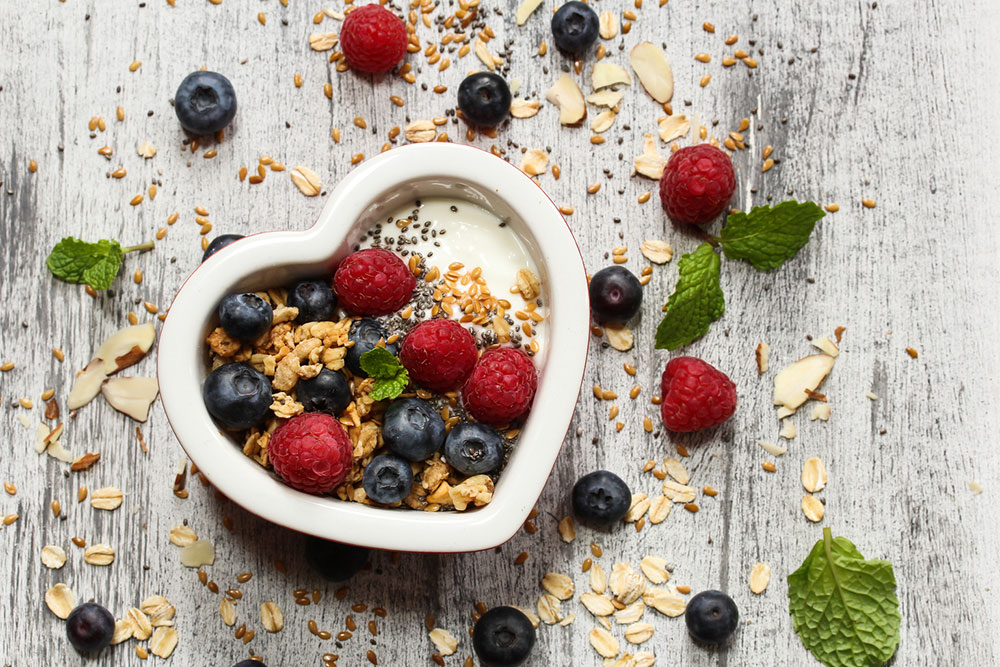35 nutritious heart-healthy breakfast ideas

For individuals with heart conditions, starting the day with a heart-healthy breakfast is a crucial step towards a better quality of life. What’s needed to improve heart health is a breakfast that’s low in saturated fats, cholesterol, and sodium, yet rich in fiber, antioxidants, and essential nutrients. So, here are 35 delicious and nutritious breakfast ideas that focus on making sure a person gets the required nutrients and enjoys a diverse array of flavors too.
Oatmeal with fresh berries and walnuts
A classic heart-healthy choice, oatmeal is packed with soluble fiber to help lower cholesterol. Top with fresh berries and chopped walnuts for added antioxidants and omega-3 fatty acids.
Spinach and mushroom egg white scramble
Swap whole eggs for egg whites, then add sautéed spinach and mushrooms for a low-cholesterol, high-protein breakfast.
Greek yogurt with honey and pecans
Greek yogurt is a protein powerhouse. Drizzle with honey and sprinkle with chopped pecans for a satisfying crunch and heart-boosting nutrients.
Chia seed and berry breakfast bowl
Mix chia seeds with almond milk and top with a medley of fresh berries and a drizzle of maple syrup for a fiber-rich and antioxidant-packed bowl.
Avocado and tomato breakfast wrap
A whole-wheat wrap filled with sliced avocado, tomatoes, and a touch of salsa provides healthy fats, vitamins, and a flavorful start to the day.
Whole-grain pancakes with banana slices
Opt for whole-grain pancake batter and add banana slices to the mix. Top with a dollop of Greek yogurt for creaminess and added protein.
Smoothie bowl with kale and mango
Blend kale, mango, and a scoop of protein powder with almond milk for a nutritious and refreshing breakfast. Top with granola and sliced almonds for crunch.
Cottage cheese with pineapple and cinnamon
Low-fat cottage cheese mixed in with fresh pineapple chunks and a sprinkle of cinnamon gives a protein-rich and vitamin C-loaded morning meal.
Quinoa and nut butter breakfast bowl
A great way to keep the heart healthy through breakfast is by cooking quinoa in almond milk. Drizzle with any favored nut butter on top, and add sliced bananas or apples for a protein-packed start.
Whole-grain waffles with berry compote
Whip up whole-grain waffles and top with a homemade berry compote. The compote adds natural sweetness and the goodness of antioxidants to the meal.
Veggie omelet with feta cheese
Make an egg white omelet with sautéed bell peppers, onions, and tomatoes. Add a sprinkle of feta cheese for a creamy and flavorful twist.
Homemade nutty granola
A quick and easy breakfast option for a healthy heart is a batch of homemade granola using oats, nuts, seeds, and a touch of honey. Enjoy with skim milk or almond milk for a fiber-rich meal.
Smoked salmon and cream cheese bagel
Spread low-fat cream cheese on a whole-grain bagel and top with smoked salmon, capers, and red onion for a luxurious yet heart-healthy breakfast.
Brown rice and berry porridge
Brown rice provides a hearty, cholesterol-friendly base to any meal. Use it as a breakfast option by cooking the rice in almond milk and topping it with berries and a drizzle of honey.
Veggie breakfast burrito with black beans
Top a whole-grain tortilla with scrambled egg whites, sautéed bell peppers, onions, and black beans for a savory, protein-packed meal.
Baked sweet potato with cinnamon and Greek yogurt
Rich in fiber fiber, sweet potato makes for a great heart-healthy meal for the day. Bake it to golden brown and top it with Greek yogurt and a dash of spice, like cinnamon. This combo is rich in vitamins, fiber, and flavor.
Mixed fruit salad with mint
Create a vibrant fruit salad with a mix of berries, oranges, apples, and grapes. Finish with a garnish of chopped mint leaves for a refreshing start.
Tofu and veggie scramble
This is a cholesterol-free, protein-rich alternative to traditional scrambled eggs. Just crumble tofu and sauté with turmeric, black salt, and any veggies.
Peanut butter and banana smoothie
Blend natural peanut butter, banana, and almond milk for a creamy and protein-packed breakfast option.
Hummus and veggie wrap
Spread hummus on a whole-grain tortilla and fill it with sliced cucumbers, bell peppers, and cherry tomatoes for a fiber-rich and savory morning meal.
Cranberry and almond quinoa bowl
Cook quinoa in almond milk, then add dried cranberries, sliced or chopped almonds, and a drizzle of honey for a sweet breakfast option.
Blueberry and oat bran muffins
Bake homemade blueberry muffins using oat bran and fresh blueberries for a fiber-rich and heart-healthy morning meal.
Cantaloupe boat with cottage cheese
This is a creative breakfast option that is intensely good for the heart. Simply hollow out a cantaloupe and fill it with a mixture of low-fat cottage cheese and diced melon for a refreshing and protein-packed start to the day.
Homemade breakfast burrito bowl
Create a burrito bowl with brown rice, black beans, scrambled egg whites, salsa, and avocado for a hearty and satisfying start to the day.
Sardine and tomato toast
Mash canned sardines with diced tomatoes and spread on whole-grain toast. Sardines are rich in omega-3 fatty acids, perfect for maintaining a healthy heart.
Veggie and cheese breakfast quesadilla
Make a veggie-loaded quesadilla with whole-grain tortillas, reduced-fat cheese, and sautéed spinach, mushrooms, and onions.
Walnut and banana oat bars
Bake oat bars with mashed bananas and chopped walnuts for a nutritious and convenient breakfast on the go.
Peach and almond butter toast
Another breakfast idea for a healthy heart is to spread almond butter on whole-grain toast and top with sliced peaches for sweet and earthy flavors.
Quinoa and veggie breakfast bowl
Another heart-healthy, savory breakfast option is cooking quinoa with sautéed zucchini, cherry tomatoes, and a sprinkle of Parmesan cheese.
Buckwheat pancakes with mixed berries
Try buckwheat pancakes with a mix of fresh berries. Drizzle a little agave nectar for some sweetness to this gluten-free and antioxidant-rich breakfast.
Pumpkin and flaxseed porridge
Cook rolled oats with pumpkin puree and ground flaxseeds for a fiber-rich and nutrient-packed starter meal of the day.
Fruit and nut oatmeal
Take regular oatmeal to the next level with dried fruits, chopped nuts, and a dash of cinnamon for added flavor, fiber, and heart-healthy fats.
Egg white and spinach breakfast wrap
Fill a whole-wheat wrap with egg whites, sautéed spinach, and a sprinkle of low-fat cheese for a protein-packed breakfast.
Homemade bran flakes with fresh fruit
Bran flakes can be made at home for a quick breakfast. Add a variety of fresh fruits like strawberries, bananas, and kiwi to the bran for a fiber-rich start.
Roasted veggie and hummus bagel sandwich
Spread hummus on a whole-grain bagel and roast a medley of vegetables. Add the roasted veggies to the bagel for a fiber-filled and flavorful morning.


